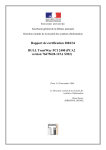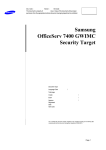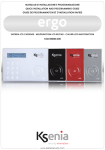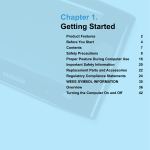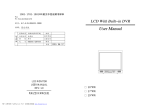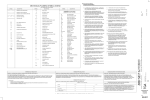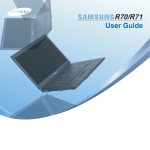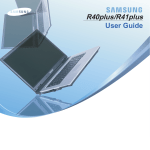Download Samsung P55 User's Manual
Transcript
P55 User Guide Chapter 1. Getting Started Product Features 2 Before You Start 3 Contents 5 Safety Precautions 6 Proper Posture During Computer Use 15 Important Safety Information 18 Replacement Parts and Accessories 20 Regulatory Compliance Statements 22 WEEE SYMBOL INFORMATION 32 Overview 33 Front View Status Indicators Right View Left View 6 Back View 7 Bottom View 8 Turning the Computer On and Off 39 Turning the computer on 9 Turning the computer off 9 Product Features High Performance Notebook Computer A high performance computer adopting the latest CPU and DDR II memory ■ ■ ■ ■ Intel Core™2 Duo Processor*,DDR II Memory Wireless LAN*, Bluetooth* PCI-Express Graphics* Fingerprint recognition*, TPM(Truted Platform Module)* Sophisticated Design for Increased Usability ■ Various shortcut keys on the keyboard ■ Multi card slot* ■ Luxurious design with increased usability * The items marked with this symbol are optional items that are supported depending on the computer model. Before You Start Before reading the User Guide, first check the following information. User Guide Information Utilizating the User Guide This product is supplied with an Installation Guide, and a User Guide. You can even more easily and conveniently use the computer by using any of the guides depending on your needs. Be sure to read the Safety Precautions before using the computer. Refer to the separately supplied Installation Guide when installing your computer. Refer to the User Guide for the procedures to use the computer. Installation Guide Using the Index of the User Guide, you can easily find This guide is provided so that you can conveniently refer to this guide when using the computer for the first time after purchasing it. This document includes the computer components and the connection procedures. any information you are looking for. Using the Glossary of the User Guide, you can easily find meanings for technical terms. If a problem occurs, refer to the Q & A included in the User Guide. User Guide ■ Some devices and software referred in the User Guide may not be provided and/or changed by upgrade. Note that the computer environment referred in the User Guide may not be the same as your own environment. The document you are currently reading is the User Guide. You can read it by double-clicking the icon on the Desktop. This document includes the computer functions, how to use the functions, and how to use the program. ■ The image used for the cover and text of the User Guide may not be the same as actual ones. ■ This guide decribes procedures for both the mouse and the touchpad together. ■ The figures in this guide are provided assuming that your operating system is Windows XP. The figures are subject to change. ■ The User guide supplied with computer may be varied depending on model. Safety Precaution Notations Icon Notation Description Warning Failing to follow instructions marked with this symbol, may cause personal injury and or fatality. Caution Failing to follow instructions marked with this symbol, may cause slight injury to yourself or damage your property. Copyright © 2007 Samsung Electronics Co., Ltd. Samsung Electronics Co., Ltd. owns the copyright of this manual. No part of this manual may be reproduced or transmitted in any form or by any means, electronic or mechanical, without the consent of Samsung Electronics Co., Ltd. The information in this document is subject to change without notice due to improving the performance of the product. Samsung Electronics shall not be liable for any data loss. Please take care to avoid losing any important data and backup your data to prevent any such data loss. Text Notations Icon Precautions for Operating System Support Notation Description Before You Start Content included in this section includes information required before using a function. Caution Content included in this section includes information required about the function. Note Content included in this section includes helpful information to use the function. Page XX This notation represents the page number you can refer to for information about related functions or as a reference. Start > All Programs > Samsung > User Guide > User Guide The operating system (OS) installed on this product is the latest version of Windows Vista. You cannot install an operating system other than Windows Vista as well as any unauthorized copy of Windows Vista. Example) When trying to install Windows Vista Home Premium when Windows Vista Home Basic is already installed. Other operating systems (Windows 98, Windows ME, Windows 2000, Windows 2003 server, UNIXand LINUX, other Windows Vista versions, etc.) other than the operating system already installed on this computer are not supported. If a problem occurs because of the installation of another operating system, the company will not provide technical support, a replacement or refund, and if our service engineer visits you due to this problem, a service charge will be applied. In addition, installing a program that does not support Windows Vista, may cause the program to not work properly. This represents a menu path to run a program. Click the Start button and then select All Programs > Samsung > User Guide > User Guide in this order from the menu. In this case, ask the corresponding software manufacturer about the problem. If you request our services to resolve a problem caused by incompatible software, a service charge will be applied. Contents Chapter 1. Getting Started Product Features 2 Before You Start 3 Contents 5 Safety Precautions 6 Proper Posture During Computer Use 15 Important Safety Information 18 Safety instructions 18 Replacement Parts and Accessories 20 Regulatory Compliance Statements 22 WEEE SYMBOL INFORMATION 32 Overview 33 Front View33 Status Indicators34 Right View35 Left View36 Back View37 Bottom View38 Turning the Computer On and Off 39 Turning the computer on39 Turning the computer off39 Chapter 2. Using the Computer Keyboard 41 Touchpad 44 CD Drive 47 Inserting and Ejecting a CD 47 Burning a CD48 HD DVD (Optional)49 Blu-ray (Optional)51 Multi Card Slot 53 Using the PC Card Slot 56 Connecting a Monitor / TV 57 Connecting a Monitor57 Connecting a TV58 Viewing Through a Monitor59 Using Dual View to View Extended Screen 60 Using Digital Output (S/PDIF) 62 Adjusting the Volume 66 Using Recorders 67 Chapter 3. Using Microsoft Windows XP About Microsoft Windows XP Tour Windows XP Help and Support Windows XP Screen Layout Desktop Start Menu Window Control Panel Running Control Panel Running the Control Panel User Account Changing Resolution and Color 69 69 70 71 71 72 73 74 74 75 76 78 Chapter 4. Using the Network Wired Network 80 Wireless Network 83 Connecting to Wireless LAN 84 Connecting to computer-to-computer networks (peer-to-peer or ad hoc) 85 Wireless Network Setup Using the Wireless LAN Setup Program 88 Using Samsung Network Manager 89 Perform Network Settings 89 Using the network after moving location92 Sharing Internet Access 93 Checking Network Status 97 Connecting with a Modem 98 Bluetooth 99 Bluetooth Functions 99 Bluetooth Software Setup 100 Using Bluetooth 102 Infrared Communication 107 Chapter 5. Using Applications Introducing Programs CyberLink PowerDVD (Optional) Samsung Update Plus (Optional) 110 113 114 Chapter 6. Settings and Upgrade LCD Brightness Control BIOS Setup Entering the BIOS Setup The BIOS Setup Screen Setting a Boot Password Changing the Boot Priority Upgrading Memory Battery Installing/Removing the Battery Charging Battery Checking Battery Residual Amount Using Battery Longer Using the Security Lock Port 117 118 118 120 122 124 125 127 127 128 128 129 132 Chapter 7. Appendix Using McAfee SecurityCenter (Optional) Using Samsung Magic Doctor (Optional) Diagnosing the System Reinstalling Software Running the system software Media Installing drivers and programs Questions and Answers Windows Related Display Related Sound Related Modem Related Wired LAN Related Wireless LAN Related Games and Programs Related Bluetooth HD DVD Blu-ray Security Center Other Questions Product Specifications Glossary Index Contact SAMSUNG WORLD WIDE 134 135 135 136 136 137 138 138 138 141 142 144 145 149 152 154 155 156 158 159 165 169 170 Safety Precautions For your security and to prevent damage, please read the following safety instructions carefully. Warning Failing to follow instructions marked with this symbol may cause personal injury and even fatality. Installation Related Power Related The power plug and wall outlet figures may differ depending on the country specifications and the product model. Do not install the product in places exposed to humidity such as a bathrooms. There is a danger of electric shock. Use the product within the operating conditions specified in the Manufacturers User Guide. Keep the plastic bags out of the reach of children. There is a danger of suffocation. Keep a distance of 15cm or more between the computer and the wall and do not place any objects between them. This may increase the internal temperature of the computer and may cause an injury. Do not install the computer on a slant or a place prone to vibrations, or avoid using the computer in that location for a long time. This increases the risk that a malfunction or damage to the product will occur. Do not touch the mains plug or power cord with wet hands. There is a danger of electric shock. Do not exceed the standard capacity (voltage/current) of a multi-plug or power outlet extension when using it for the product. There is a danger of electric shock or fire hazard. If the power cord or power outlet makes a noise, disconnect the power cord from the wall outlet and contact a service center. There is a danger of electric shock or fire hazard. Plug the power cord firmly into the power outlet and AC adapter. Failing to do so may cause fire hazard. Do not bend the power cord excessively or do not place a heavy object over the power cord. It is especially important to keep the power cord out of reach of infants and pets. If the cord is damaged, it may cause electric shock or fire. Use a wall outlet or multi-plug with a grounding part. Do not use a damaged or loose mains plug or power cord or power outlet. Do not unplug the power cord out by pulling the cable only. If the cord is damaged, it may cause electric shock. There is a danger of electric shock or fire hazard. Failing to do so may cause electric shock hazard. Battery Usage Related If water or another substance enters the power input jack, AC adapter or the computer, disconnect the power cord and contact the service center. Damage to the device within the computer may cause electric shock or fire hazard. Usage Related Keep the battery out of the reach of infants and pets, as they could put the battery into their mouths. Disconnect all cables connected to the computer before cleaning it. If you are using a notebook computer, remove the battery. There is a danger of electric shock or choking. There is a danger of electric shock or damage to the product. Do not connect a phone line connected to a digital phone to the modem. There is a danger of a electric shock, fire or damage to the product. Upgrade Related Do not place any container filled with water or chemicals over or near the computer. If water or chemicals enter the computer, this may cause fire or electric shock. Avoid direct sunlight when the computer is in an air-tight location such as inside a vehicle. There is a danger of a fire hazard. The computer may overheat and also present opportunity to thieves. Never disassemble the power supply or AC adapter. There is a danger of electric shock. When removing the RTC (Real Time Clock) battery, keep it out of the reach of children as they could touch and/or swallow it. There is a danger of choking. If a child has swallowed it, contact a doctor immediately. If the computer is broken or dropped, disconnect the power cord and contact a service center for a safety check. Use only authorized parts (multi-plug, battery and memory) and never disassemble parts. Using a broken computer may cause electric shock or fire hazard. There is a danger of damaging the product, electric shock or fire hazard. Upgrade Related Shut down the computer and disconnect all cables before disassembling the computer. If there is a modem, disconnect the phone line. If you are using a notebook computer, make sure to remove the battery. Custody and Movement Related Follow the instructions for the relevant location (e.g. airplane, hospital, etc.) when using a wireless communication device (wireless LAN, Bluetooth, etc.). Failing to do so, may cause electric shock. 10 Caution Failing to follow instructions marked with this symbol may cause slight injury or damage to the product. Installation Related Battery Usage Related Do not block the ports (holes), vents, etc. of the product and do not insert objects. Dispose of worn-out batteries properly. Damage to a component within the computer may cause electric shock or fire. When using the computer with it lying on its side, place it so that the vents face upwards. Failing to do so, may cause the internal temperature of the computer to rise and the computer to malfunction or halt. - There is a danger of fire or explosion. - The battery disposal method may differ depending on your country and region. Dispose of the used battery in an appropriate way. Do not throw or disassemble the battery and do not put it into water. This may cause an injury, fire or explosion. Do not place a heavy object over the product. Use only a battery authorized by Samsung Electronics. This may cause a problem with the computer. In addition, the object may fall and cause injury, or damage the computer. Failing to do so may cause an explosion. Avoid contact with metal objects such as car keys or clips when keeping or carrying a battery. Contact with a metal may cause 11 excessive current and a high temperature and may damage the battery or cause a fire. Charge the battery according to the instructions in the manual. Failing to do so, may cause and explosion or fire from damage to the product. Do not heat the battery or expose it to heat (e.g. inside a vehicle during the summer). There is a danger of explosion or fire. Usage Related Do not place a candle, lighted cigar, etc. over or on the product. There is a danger of fire. Make sure to have the product tested by a safety service engineer after repairing the product. Authorised Samsung Repair Centers will carry out safety checks after a repair. Using a repaired product without testing it for safety might cause electric shock or fire. Close the LCD panel only after checking if the notebook computer is turned off. Failing to do so, may cause damage to the product. The temperature may rise and it may cause overheating and deformation of the product. If the computer emits smoke, or there is a burning smell, disconnect the power plug from the wall outlet and contact a service center. If your computer is a note-book computer, make sure to remove the battery. Do not press the Eject Button while the Floppy Disk/CD-ROM drive is in operation. You might lose data and the disk might be suddenly ejected and could cause an injury. There is a danger of fire. Do not use a damaged or modified CD/Floppy Disk. In case of lightning, immediately turn the system off, disconnect the power cord from the wall outlet and line do not use a modem or phone. Take care not to drop the product while using it. There is a danger of electric shock or fire. Do not contact the antenna with electricity facility such as the power outlet. There is a danger of injury or electric shock. There is a danger of electric shock. Use recommended computer cleansing solution when cleaning the product and only use the computer when it is completed dried. Connect only permitted devices to the connectors or ports of the computer. Failing to do so, may cause electric shock and fire. This may cause personal injury or loss of data. When handling computer parts, follow the instructions on the manual supplied with the parts. 12 There is a danger of damaging the product or personal injury. Do not insert your fingers into the PC Card Slot. Upgrade Related Failing to do so may cause electric shock or fire. Emergency disk eject method using paperclip should not be used while the disk is in mothion. Make sure to use the emergency disk eject method only when the Optical Disk Drive is stopped. There is a danger of injury. Do not place your face close to the Optical Disk Drive tray when it is operating. There is a danger of injury due to an abrupt ejection. Check CDs for cracks and damage prior to use. It may damage the disc and cause disorder of device and injury of user. Take care when touching the product or parts. Never disassemble or repair the product by yourself. The device may be damaged or you may be injured. There is a danger of electric shock or file. Take care not to throw or drop a computer part or device. To connect a device that is not manufactured or authorized by Samsung Electronics, enquire at your service center before connecting the device. This may cause injury or damage to the product. Make sure to close the computer cover before connecting the power after a reassembly. There is a danger of electric shock if your body touches an internal part. Use parts authorized by Samsung Electronics only. Failing to do so, may cause fire or damage the product. 13 There is a danger of damaging the product. Custody and Movement Related Cautions on Preventing Data Loss (Hard Disk Management) When moving the product, turn the power off and separate all connected cables first. Take care not to damage the data on a hard disk drive. The product might be damaged or users may trip over the cables. ■ A hard disk drive is so sensitive to external impact that an external impact may cause loss of data on the surface of the disk. For long periods of not using the notebook computer, discharge the battery and preserve as it is detached. ■ Take extra care, because moving the computer or an impact on the computer when it is turned on may damage the data of the hard disk drive. The battery will be preserved at its best condition. Do not operate or watch the computer while driving a vehicle. ■ The company is not liable for the loss of any data caused by customer such as the careless-ness usage or bad environmental condition. Causes that may damage the data of a hard disk drive and the hard disk drive itself. ■ The data may be lost when an external impact is applied to the disk while disassembling or assembling the computer. ■ The data may be lost when the computer is turned off or reset by a power failure while the hard disk drive is operating. ■ The data may be lost and irrecoverable due to a computer virus infection. ■ The data may be lost if the power is turned off while running a program. ■ Moving or causing an impact to the computer while the hard disk drive is operating, may cause files to be corrupted or bad sectors on the hard disk. There is a danger of a traffic accident. Please concentrate on driving. To prevent data loss due to damage to the hard disk drive, please backup your data frequently. 14 Proper Posture During Computer Use Maintaining a proper posture during computer use is very important to prevent physical harm. The following instructions are about maintaining a proper posture during computer use developed through human engineering. Please read and follow them carefully when using the computer. Otherwise, the probability of (RSI: Repetitive Strain Injury) from repeated operations may increase and serious physical harm may be caused. The instructions in this manual have been prepared so that they can be applied within the coverage of general users. If the user is not included in the coverage, the recommendation is to be applied according to the user’s needs. Since this is commonly applied to Samsung Computers, some figures may differ from actual ones. Proper Posture Adjust the heights of desks and chairs appropriate to your height. The heights are to be adjusted so that your arm forms a right angle when you place your hand over the keyboard while sitting down on a chair. ■ Adjust the height of chair so that your heel is comfortably placed on the floor. ■ Do not use the computer while you are lying down, but only while you are sitting down. ■ Do not use the computer on your lap. If the computer temperature increases, there is a danger of burning yourself. ■ Work while keeping your wrist straight. ■ Use a chair with a comfortable back. ■ Keep the center of your leg weight not on the chair but on your feet when you are sitting on a chair. 15 Eye Position Hand Position Keep the monitor or LCD away from your eyes by at least 50cm. Keep your arm at a right angle as shown by the figure. m 50c ■ Adjust the height of the monitor and the LCD screen so that its top height is equal to or lower than your eyes. ■ Keep the line from your elbow to your hand straight. ■ Avoid setting the monitor and LCD excessively bright. ■ Do not hold the mouse with excessive force. ■ Keep the monitor and LCD screen clean. ■ Do not press the keyboard, touchpad or mouse with excessive force. ■ Do not place your palm over the keyboard while typing. ■ If you wear glasses, clean them before using the computer. ■ It is recommended connecting an external keyboard and mouse when using the computer for long periods of time. ■ When entering contents printed on a paper into the computer, use a static paper holder so that the height of the paper is almost equal to that of the monitor. 16 Illumination Volume Control (Headphones and Speakers) ■ Do not use the computer in dark locations. The illumination level for computer use must be as bright so for reading a book. Check your volume first to listen to music. ■ Indirect illumination is recommended. Use a curtain to prevent reflection on the LCD screen. Click your volume!! Operation Condition ■ Do not use the computer in hot and humid locations. ■ Check if the volume is too loud before using headphones. ■ Use the computer within the allowed temperature and humidity range specified in the User Guide. ■ It is not recommended using headphones for long periods of time. Use Time (Break Time) ■ Take a break for 10 minutes or more after a 50-minute period when working for more than one hour. 17 Important Safety Information Safety instructions Your system is designed and tested to meet the latest standards for safety of information technology equipment. However, to ensure safe use of this product, it is important that the safety instructions marked on the product and in the documentation are followed. ■ Openings in the computer case are provided for ventilation. Do not block or cover these openings. Make sure you provide adequate space, at least 6 inches (15 cm), around the system for ventilation when you set up your work area. Never insert objects of any kind into the computer ventilation openings. ■ Ensure that the fan vents on the bottom of the casing are clear at all times. Do not place the computer on a soft surface, doing so will block the bottom vents. Always follow these instructions to help guard against personal injury and damage to your system. ■ If you use an extension cord with this system, make sure that the total power rating on the products plugged into the extension cord does not exceed the extension cord power rating. Setting Up your System ■ Read and follow all instructions marked on the product and in the documentation before you operate your system. Retain all safety and operating instructions for future use. ■ Do not use this product near water or a heat source such as a radiator. ■ Set up the system on a stable work surface. ■ The product should be operated only with the type of power source indicated on the rating label. ■ Ensure that the electrical outlet you are using to power your equipment is easily accessible in case of fire or short circuit. ■ If your computer has a voltage selector switch, make sure that the switch is in the proper posi-tion for your area. 18 Care During Use The Instruction On Safety Operation of NotePC ■ Do not walk on the power cord or allow anything to rest on it. 1 ■ Do not spill anything on the system. The best way to avoid spills is to not eat or drink near your system. ■ Some products have a replaceable CMOS battery on the system board. There is a danger of explosion if the CMOS battery is replaced incorrectly. Replace the battery with the same or equivalent type recommended by the manufacturer. 2 ■ When the computer is turned off, a small amount of electrical current still flows through the computer. To avoid electrical shock, always unplug all power cables, remove the battery and modem cables from the wall outlets before cleaning the system. 3 ■ Unplug the system from the wall outlet and refer servicing to qualified personnel if: 4 – The power cord or plug is damaged. – Liquid has been spilled into the system. – The system does not operate properly when the operating instructions are followed. – The system was dropped or the casing is damaged. – The system performance changes. 19 When installing and operating devices please refer to safety requirements in the user guide. Devices can be used only with the equipment specified in the technical specifications of the devices. If any smell of burning or smoke from the computer the unit should be switched off and battery removed. The unit should be checked by a qualified technician before reuse. Service and repair of devices should be carried out by authorized service centers. Replacement Parts and Accessories Use only replacement parts and accessories recommended by manufacturer. To reduce the risk of fire, use only No. 26 AWG or larger telecommunications line cord. Do not use this product in areas classified as hazardous. Such areas include patient care areas of medical and dental facilities, oxygen rich environments, or industrial areas. Battery Disposal Laser Safety All systems equipped with CD or DVD drives comply with the appropriate safety standards, including IEC 608251. The laser devices in these components are classified as “Class 1 Laser Products” under a US Department of Health and Human Services (DHHS) Radiation Performance Standard. Should the unit ever need servicing, contact an authorized service location. To reduce the risk of fire, use only No. 26 AWG or larger telecommunications line cord. Contact the Samsung Helpline for information on how to dispose of batteries that you cannot use or recharge any longer. Follow all local regulations when disposing of old batteries. ■ Laser Safety Note: Use of controls or adjustments or performance of procedures other than those specified in this manual may result in hazardous radiation exposure. To prevent exposure to laser beams, do not try to open the enclosure of a CD or DVD drive. THERE IS A RISK OF EXPLOSION IF BATTERY IS REPLACED BY AN INCORRECT TYPE. DISPOSE OF USED BATTERIES ACCORDING TO THE INSTRUCTIONS 20 ■ Class 1M laser radiation when operating part is open. Do not view directly with optical instruments. ■ Class 3B invisible laser radiation when open. Avoid exposure to the beam. General Requirements Connect and Disconnect the AC adapter The requirements listed below are applicable to all countries: The socket-outlet shall be installed near the equipment and shall be easily accessible. ■ The length of the power cord set must be at least 6.00 feet (1.8m) and a maximum of 9.75 feet (3.0m). Do not unplug the power cord out by pulling the cable only. ■ All power cord sets must be approved by an acceptable accredited agency responsible for evaluation in the country where the power cord set will be used. ■ The power cord set must have a minimum current capacity of 7 A and a nominal voltage rating of 125 or 250 volts AC, as required by each country’s power system. Power Cord Requirements The power cord set (wall plug, cable and AC adapter plug) you received with your computer meets the requirements for use in the country where you purchased your equipment. ■ The appliance coupler must meet the mechanical configuration of an EN 60 320/IEC 320 Standard Sheet C7 connector, for mating with appliance inlet on the computer. Power cord sets for use in other countries must meet the requirements of the country where you use the computer. For more information on power cord set requirements, contact your authorized dealer, reseller, or service provider. 21 Regulatory Compliance Statements Wireless Guidance Low power, Radio LAN type devices (radio frequency (RF) wireless communication devices), operating in the 2.4 GHz Band, may be present (embedded) in your notebook system. The following section is a general overview of considerations while operating a wireless device. Additional limitations, cautions, and concerns for specific countries are listed in the specific country sections (or country group sections). The wireless devices in your system are only qualified for use in the countries identified by the Radio Approval Marks on the system rating label. If the country you will be using the wireless device in, is not listed, please contact your local Radio Approval agency for requirements. Wireless devices are closely regulated and use may not be allowed. The RF field strength of the wireless device or devices that may be embedded in your notebook are well below all international RF exposure limits as known at this time. Because the wireless devices (which may be embedded into your notebook) emit less energy than is allowed in radio frequency safety standards and recommendations, manufacturer believes these devices are safe for use. Regardless of the power levels, care should be taken to minimize human contact during normal operation. As a general guideline, a separation of 20 cm (8 inches) between the wireless device and the body, for use of a wireless device near the body (this does not include extremities) is typical. This device should be used more than 20 cm (8 inches) from the body when wireless devices are on and transmitting. (This Statement is not applicable to UMPC(Ultra Mobile PC) such as PDA, Portable PC.) This transmitter must not be collocated or operate in conjunction with any other antenna or transmitter except the installed Bluetooth transmitter. Some circumstances require restrictions on wireless devices. Examples of common restrictions are listed below: 22 ■ Radio frequency wireless communication can interfere with equipment on commercial aircraft. Current aviation regulations require wireless devices to be turned off while traveling in an airplane. 802.11B (also known as wireless Ethernet or Wifi) and Bluetooth communication devices are examples of devices that provide wireless communication. ■ In environments where the risk of interference to other devices or services is harmful or perceived as harmful, the option to use a wireless device may be restricted or eliminated. Airports, Hospitals, and Oxygen or flammable gas laden atmospheres are limited examples where use of wireless devices may be restricted or eliminated. When in environments where you are uncertain of the sanction to use wireless devices, ask the applicable authority for authorization prior to use or turning on the wireless device. ■ Every country has different restrictions on the use of wireless devices. Since your system is equipped with a wireless device, when traveling between countries with your system, check with the local Radio Approval authorities prior to any move or trip for any restrictions on the use of a wireless device in the destination country. ■ If your system came equipped with an internal embedded wireless device, do not operate the wireless device unless all covers and shields are in place and the system is fully assembled. ■ Wireless devices are not user serviceable. Do not modify them in any way. Modification to a wireless device will void the authorization to use it. Please contact manufacturer for service. ■ Only use












































































































































































